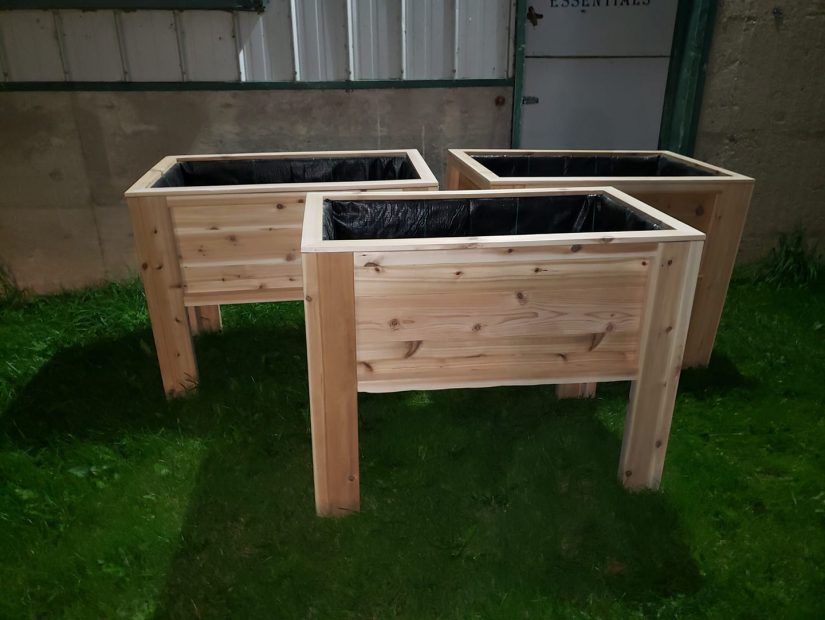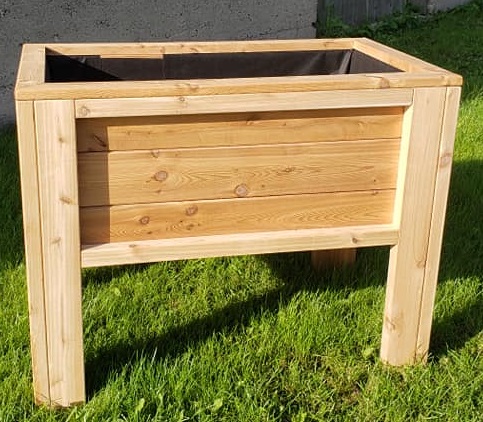Digging in the dirt improves your mental health
We were contacted by the Principal at CCH and asked to build 3 raised cedar garden boxes. They are hoping to incorporate the boxes into the Mental Health programs. COVID-19 has been especially hard on our teenagers and the school is looking outside the box to try to find ways to help their students. I have worked in the field of mental health for over a decade and this was a project I could truly get behind! There are several studies that suggest the soil has nutrients, that when absorbed by the skin, actually increase feelings of calm and well-being. You can read about here.
The benefits of elevated a raised garden box
The perks of gardening in elevated raised beds are many. Aside from the obvious advantage of never having to bend over or kneel to plant or pick your peppers and pansies, gardening in an elevated planter box means you’ll be able to enjoy the following:
- No weeds (take that, bittercress!)
- No ground-dwelling pests to nibble plant roots
- No soil-borne fungal diseases to contend with
- No rabbits and groundhogs munching on your lettuce
- No need to set up a sprinkler or drip system to water
- No issues with water-logged clay soil or fast-draining sandy soil
- No need to leave the deck or patio to harvest
- No back aches, creaking knees, or inflamed hip joints (goodbye, ibuprofen!)
Selecting raised planter boxes/elevated raised beds

When shopping for an elevated raised bed, here are a few traits to keep in mind.
1. First and foremost, look for a planter that has drainage and is made from materials that will last for many years. The beautiful elevated raised bed from Naturally Knotty Farms shown above, for example, is made from naturally rot-resistant cedar boards with sturdy, cedar 2×4 legs. It will weather many seasons without issue, and the legs can support hundreds of pounds of soil, plant material and moisture.
2. Make sure your raised planter box is a safe place to grow food. If you plan to plant edibles, it should be free from plastics, harmful paints and stains, and chemically preserved woods. (This is why we chose to build all garden boxes in cedar.)
3. Next, consider the planter’s size. Elevated raised bed gardening means the roots of your plants will be restricted by the dimensions of the bed. Make sure the raised planter you choose is deep enough to handle root crops, like carrots and parsnips, and provides plenty of room for the roots of larger plants, like tomatoes, eggplants, sunflowers, and others. The dimensions of the planter box featured in this article are 48″ long, 24″ wide, and 14″ deep — perfect for a wide range of flowers, fruits, veggies, and herbs! If that’s too long for your space, we can build to your specifications.
4. The total height of your elevated raised bed garden is important, as well. If it’s too tall, you’ll get tired of reaching up, but if it’s not tall enough, the constant slight bend in your back will have you at the chiropractor’s in short order. The featured boxes are approximately 32″ , but again, can be altered to meet your needs.
5. Lastly, it’s important to consider the planter’s maintenance needs. Elevated raised bed gardening is supposed to make your life easier, not complicate it. Skip planter boxes that require yearly painting or staining, or those that will rust, warp, or become brittle with constant exposure to sunlight.
Placing your elevated garden box
Once you’ve selected the elevated raised bed that’s right for you, it’s time to put it in place. These planters are heavy when filled to the brim with soil, so don’t fill the planter box until you’re happy with its placement.
Most fruits and veggies require at least 6 to 8 hours of full sun. Gardeners planning to grow edibles when elevated raised bed gardening need to place the planters in full sun. If you’re growing sun-loving annuals, the rule is the same. But for shade-lovers, a nice spot in the shade or part shade will do just fine.
In addition, make sure your raised planter box is close to a spigot or rain barrel to make watering a snap. Lugging watering cans to a distant location every day can be a real drag. Keeping your garden close to the kitchen door is a plus, too!
Filling your raised garden box
As with in-ground growing, the secret to successful elevated raised bed gardening is in the soil. While most elevated planter boxes are sturdy, they aren’t built to hold heavy, clay-based garden soil. Instead, they’re designed to be filled with a mixture of high-quality potting soil and compost. Mix 2/3 potting soil with 1/3 compost, toss in a few handfuls of organic granular fertilizer, and you’ll be ready to grow! (Unless, of course, you’re going to be growing cacti and/or succulents in your raised planter; in that case add coarse builder’s sand to the mix, instead of compost.)
What to grow when elevated cedar garden box
When it comes to gardening in raised planters, the possibilities are endless! There are so many plants that will do wonderfully in such an environment.
- Plant an elevated raised bed full of compact vegetable varieties, including ‘Tumbling Tom’ tomatoes, ‘Fairy Tale’ eggplants, ‘Mohawk Patio’ peppers, and ‘Thumbelina’ carrots.
- Or how about growing an herbal paradise? ‘Spicy Globe’ basil, creeping thyme, lemongrass, rosemary, and parsley will perform to perfection.
- Small-statured berry plants, such as ‘Strawberry Shortcake’ red raspberries, ‘Top Hat’ blueberries, and strawberries, are beautiful and productive in an elevated raised bed.
- Flowers are another lovely option. Most annuals do quite well in raised planters, just be sure to include a few trailing varieties to spill over the bed’s edge.
- Fairy gardens and miniature plants are another unique option, especially since they’ll be at eye-level for curious little hands and eyes.
- You can even plant dwarf flowering shrubs and small-statured evergreens when gardening in an elevated raised bed. Doing so will make a great privacy screen between close balconies, patios, and porches.
We hope you enjoyed this in-depth look at the many advantages of elevated raised bed gardening and all the possibilities it brings to the landscape.
Naturally Knotty Farm‘s cedar outdoor garden boxes are hand-crafted with top quality Western Red Cedar. Cedar is naturally resistant resistant to rot and decay. It is safe to use with any type of plant and its richness of grain, colour and texture will enhance any outdoor living space.
- Choose to have your box lined with high-quality, heavy-duty landscape fabric, this helps reduce the dirt and water escaping, cedar contains natural preservatives that resist moisture, decay and insect damage thereby increasing the life of the planter
- Planters are assembled using premium 5/4 -inch western red cedar boards and framed with 1 x 2 western red cedar, fastened with outdoor decking screws and cut on 45° angle creating a superior structure
- Planters are sold natural and untreated but they can be stained or painted. We also offer engraving to personalize your Garden
- Several sizes and shapes are available: from 16″ square to 48″ rectangular
- Support boards are 5/4 -inch thick versus 1/2 -inch of competitors products
- Legs are solid 2×4 construction that continue into the frame providing a solid structure that will hold the weight of the soil, moisture & vegetation.
- Fully assembled
- Versatile for any outdoor space
- Environmentally friendly
- Adequate drainage to prevent flooding & root rot
Do you grow in raised beds or elevated planters? We’d love to hear about it in the comment section below!









Leave a Reply